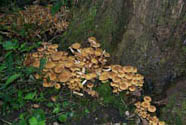Marasmius cohaerans
 Key to Gilled Mushrooms Key
Key to Gilled Mushrooms KeyThis is a key to gilled mushrooms, that is, mushrooms having a definite cap with a fertile surface consisting of gills. The fruiting body usually also has a stem, although that may be lateral or absent (usually, then, the mushroom is growing from wood). You can use this key to identify mushrooms that you find.
 Agaricales Order
Agaricales OrderFruiting body containing fibers (usually in the stalk)
 White Spored Suborder
White Spored SuborderSpore print "light-colored": white or buff, sometimes tinged with pink or tan. Greenish and (except for the Russulales) yellow spore prints also go here
Stalk fibrous, not fracturing like a piece of chalk
 Tricholomataceae Family
Tricholomataceae FamilyNone of the special features distinguishing the other white-spored genera:
Gills not free, as in the Lepiotas and Amanitas
Basidia not extra-long, as in the Hygrophoraceae
Spores smooth, except for Lentinellus
 Lignicolous Trich Subfamily
Lignicolous Trich SubfamilyGrowing on trees or dead wood, leaves, or sticks, or organic debris, often in moss
 Normal LignoTrich Tribe
Normal LignoTrich TribeShaped like a “normal mushroom”
Small and fragile to medium-sized, except for one large, grey-capped species
Small Ligno Trich SubtribeFruiting body small: cap up to 1 1/4" across (and most clearly smaller than that)
 Marasmius Genus
Marasmius GenusBasically, the members of this genus can look like members of any other SmallLignoTrich.
You might want to check here first if your mushroom is very small, has a thin, wiry stem or is revenant. Or if it looks like the picture. :-)
Else, check this genus if you can't find your mushroom anywhere else
Here are the characters that distinguish this species from the others in its group. For its more general characters, see higher up on the page.
If there's just a few words or a microscopic feature here, a more thorough description can be found above.
Diagnosis
- Cap up to 1 1/2" across, yellowish brown
-
Gills white, yellowish pink to dull greyish brown.
-
Stem hollow, shiny; white at top, shading to color of cap at bottom
-
Growing cestipose on hardwood forest litter, the base of the stalk(s) attached to a white or yellowish wad of mycelium that usually binds quite a bit of the substrate
Comments
R. Phillips (1991) 's collection was very reddish in its colored areas, and these turned green with KOH






 Key to Gilled Mushrooms Key
Key to Gilled Mushrooms Key Agaricales Order
Agaricales Order White Spored Suborder
White Spored Suborder Tricholomataceae Family
Tricholomataceae Family Lignicolous Trich Subfamily
Lignicolous Trich Subfamily Normal LignoTrich Tribe
Normal LignoTrich Tribe Marasmius Genus
Marasmius Genus




